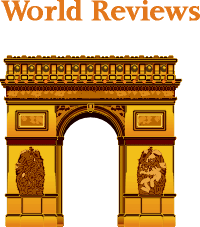

A global archive of independent reviews of everything happening from the beginning of the millennium
Read our Copyright Notice click here
For publication dates click here
JOAN MIRÓ'S DOZEN
Reviewed by ANDRE BEAUMONT
The exhibition, Joan Miró - Chefs-d'oeuvres de la Collection Namad, at the Picasso Museum in Antibes, 30 June - 27 October 2024, features twelve paintings from the private collection, one or two per room only, for maximum impact in architectural space.
I will start with a painting of 1933 as it adds a perception further to his methodology, in his own words. It also features the unusual brown grounds he used. His suggestion of form comes first from collage.
Peinture, 5 juin 1933
From 1967-68 there can be found paintings of the bird series, a few perhaps hurried along to make the major retrospective of his work, to mark his 75th birthday, at the Fondation Maeght.
A canvas from 1968 is Oiseau en fête pour le lever du jour, which seems to reference collage technique by bordering forms with a white ground.
In the same room as the 1933 canvas with the brown ground is the 1925 canvas below that echoes Toulouse Lautrec in the trickling black on the left and his friend Calder elsewhere.
Peinture, 1925
This is a powerful work that gets away from the easy viewing that makes him so readily popular.
It is his command of space, placing of objects, insertion of colour and use of grounds that is so appealing to others who do not just want easy viewing. The appearance of red above is like something that happens in collage.
Peinture (femme au chapeau rouge), 1927, uses an ultramarine ground and Le chat blanc, 1927, uses a brown ground, with the friendy face commanding space in a way cat portraiture rarely does and ushering in the lovely gradation of brown on canvas.
Femme, étoiles, 1945
His 1945 painting, above, is enigmatic as to Miró symbols and displays combinatorial success in overlaps.
Femme dans la nuit, 1945, using white-gray (over brown?) ground is less successful - the command of space would have been better without the experiment of the artist's palm prints.
Returning to the late bird theme paintings there are two rather good ones.
Oiseau dans la nuit, 1967
Le vol de l'oiseau par le clair de lune, 1967
In the upper painting the morning sun's rays bleed into the red delineation, the opposite of what could happen in collage.
In the lower one the red moon (not painted red) is properly delineated by black against a glorious green ground. Only the bird has white delineation around it, giving it motion.
The largest two bird paintings, below, are from 1968, the first from January, the second from April, with impossibly long French titles best shorthanded to 'bird woken by the cry of the blue sky' and 'difficult path trodden, guided by the bird of the desert'.
'
The emotions are there for both. Can we predict the future? With difficulty. Can an artist pre-sense the future? Probably, as they work with distilled reality. They are the best weathervane. The clear blue sky of January soon to turn into the protest of May 1968? Maybe. The symbols turn from calm to troubled.
You leave the exhibition back in the easy playfulness of early work (1927).
Out on the ever popular terrace amongst the permanent colllection you will find ....
La Déesse de la Mer
(Joan Miró with Josep Llorens Artigas, 1968)